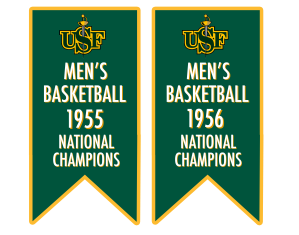Hayden Gehr
Staff Writer
 For anyone who has attended a USF basketball game at War Memorial Gym in the 21st century, it would be easy to mistake the Dons for a run-of-the mill mid-major team that has been mired in mediocrity since the basketball program’s inception. But if they happened to look up at the gym’s ceiling, the sight of the two NCAA Championship banners would instantly dispel any assumptions.
For anyone who has attended a USF basketball game at War Memorial Gym in the 21st century, it would be easy to mistake the Dons for a run-of-the mill mid-major team that has been mired in mediocrity since the basketball program’s inception. But if they happened to look up at the gym’s ceiling, the sight of the two NCAA Championship banners would instantly dispel any assumptions.
When the current Dons basketball team begins its 2014-15 season in November, it will have been 60 years since Bill Russell led USF to the first of its back-to-back NCAA Titles. In the 1954-55 and 1955-56 seasons, the Dons compiled a 57-1 record, and consistently crushed opponents on their way to becoming one of the most dominant and decorated dynasties in college basketball history. Sporting News declared the 1954-55 team the fifth best college team of all time.
“You’re not going to find many better two-year stretches in college basketball history than what USF had in the mid 1950s,” said Steve Kroner, who covers West Coast Conference basketball for the San Francisco Chronicle.
Teaming with Russell on the championship teams was K.C. Jones, a guard who complemented Russell’s shot blocking with his excellent perimeter defense. Role players such as Stan Buchanan and Hal Perry were also crucial to the Dons’ success. Ultimately, though, the team belonged to Russell, who averaged over 20 points and 20 rebounds in both 1955 and 1956.
“Russell elevated the guys around him, played whatever role they needed, was a little better of a scorer than people thought, a great rebounder, and an unbelievable defender,” said Jeff Faraudo, a sports writer for the Bay Area News Group.
Russell would go on to win 11 NBA Championships and be regarded as one of the best basketball players of all time. Surprisingly, though, USF was the only college to offer a scholarship to the lanky Oakland teenager in the 1950s.
“This was at a time that recruiting was much more geographical, and players tended to stay home,” said Jim Young, the associate athletic director of communications and community relations for USF Athletics. “For whatever reason, [Russell] didn’t attract a lot of suitors from other universities in the area, or nationally. He decided to stay close to home, and he came here to USF as a gangly, 6-foot-11 center out of McClymonds [High School].”
The 1955 and 1956 teams were primarily composed of Bay Area natives, which enhanced the group’s sense of unity. “They knew each other, and developed a kinship,” Young said. “You think of a team like that now, and it would be unheard of to get a collection of that talent from basically what amounted to a 30 mile radius.”
The Bill Russell era is also relevant when discussing USF’s values as a Jesuit Catholic university. When the Dons won the 1955 title, it was the first time in history that an NCAA Championship team had three African Americans in its starting lineup.
“They had a more racially integrated team than almost anybody had in those days,” Faraudo said. “College basketball was still kind of a white sport, and something like five of their top eight guys were African American players.”
Behind head coach Phil Woolpert, who established himself as one of the first college coaches to actively recruit African Americans, the basketball program placed importance on diversity, equality, and acceptance.
“The Dons have always had a unique place in sports history, specifically around social change and its impact on the world,” said USF Athletic Director Scott Sidwell.
After capturing two consecutive NCAA titles, USF has gone six decades without winning another, and is currently in the midst of a 16-year NCAA Tournament drought. Still, one could argue that USF’s upcoming 2014-15 season is poised to be its best one in quite a while. After earning an NIT berth last year, the Dons are returning with their core largely intact, and with an established identity to boot.
“With this team, [head coach Rex Walters] doesn’t need to coach effort,” Young said. “These guys will run through the wall, and they really have that gritty, chip-on-your-shoulder style of play that serves them very well.”
Kroner has the Dons projected to finish somewhere between third and fifth in the WCC this year, but doesn’t think it would be too far-fetched for them to win the conference. Sidwell is confident that USF can thrive through building positive habits and working on the little things.
“A lot goes into winning, and it starts with the process of how our athletes approach each day and focus on the details of achieving greatness,” Sidwell said.
If last year’s starting point guard, Avry Holmes, hadn’t transferred to Clemson, USF’s prospects may have been even more favorable.
Holmes was the only player to transfer out of USF after last season, but the university has a lengthy list of recent players who have departed before graduating. After the 2010-11 season, a whopping six Dons left the basketball team, and head coach Rex Walters’ tactics have since been questioned. However, Kroner does not believe it is fair to single out USF’s transferring issues.
“Transfers happen all over the country. It’s not solely endemic to USF,” Kroner said.
The players who have elected to stay at USF have connected themselves to a program with a rich history, one that they respect but also hope to contribute towards.
“We’re very aware of our basketball tradition, and we celebrate it, but then tradition happens today too,” Young said. “We want to carve the groundwork for new traditions on the floor.”
